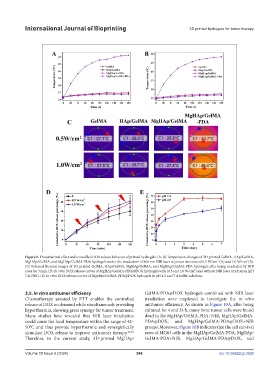Page 256 - IJB-10-5
P. 256
International Journal of Bioprinting 3D printed hydrogels for tumor therapy
Figure 9. Photothermal effect and controlled DOX release behavior of printed hydrogels. (A, B) Temperature changes of 3D-printed GelMA, HAp/GelMA,
2
2
MgHAp/GelMA, and MgHAp/GelMA-PDA hydrogels under the irradiation of 808 nm NIR laser at power densities of 0.5 W/cm (A) and 1.0 W/cm (B).
(C) Infrared thermal images of 3D-printed GelMA, HAp/GelMA, MgHAp/GelMA, and MgHAp/GelMA-PDA hydrogels after being irradiated by NIR
laser for 3 min. (D) In vitro DOX release curves of MgHAp/GelMA-PDA@DOX hydrogels with (0.5 and 1.0 W/cm ) and without NIR laser irradiation (pH
2
7.4, PBS). (E) In vitro DOX release curves of MgHAp/GelMA-PDA@DOX hydrogels in pH 4.5 and 7.4 buffer solutions.
3.5. In vitro antitumor efficiency GelMA-PDA@DOX hydrogels combined with NIR laser
Chemotherapy assisted by PTT enables the controlled irradiation were employed to investigate the in vitro
release of DOX on demand while simultaneously providing antitumor efficiency. As shown in Figure 10A, after being
hyperthermia, showing great synergy for tumor treatment. cultured for 4 and 24 h, many bone tumor cells were found
Many studies have revealed that NIR laser irradiation dead in the MgHAp/GelMA-PDA+NIR, MgHAp/GelMA-
could cause the local temperature within the range of 42– PDA@DOX, and MgHAp/GelMA-PDA@DOX+NIR
50°C and thus provide hyperthermia and synergistically groups. Moreover, Figure 10B indicates that the cell survival
stimulate DOX release to improve anticancer therapy. 4,9,65 rates of MG63 cells in the MgHAp/GelMA-PDA, MgHAp/
Therefore, in the current study, 3D-printed MgHAp/ GelMA-PDA+NIR, MgHAp/GelMA-PDA@DOX, and
Volume 10 Issue 5 (2024) 248 doi: 10.36922/ijb.3526

